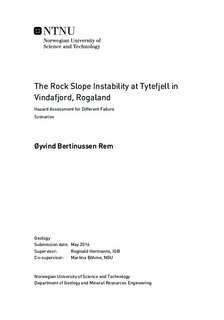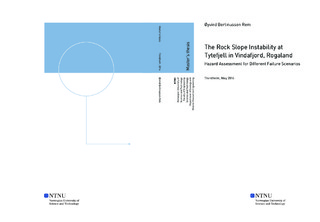| dc.description.abstract | NGU is currently in the process of identifying, classifying and completing hazard and consequence analyses of all unstable rock slopes in Norway. In the context of this long term project, a hazard analysis of the Tytefjell unstable rock slope was completed, involving detailed structural field mapping and analysis of high-resolution digital terrain models. The Tytefjell site is located in Vindafjord, Rogaland County, on an east dipping slope composed of phyllite. It is believed that the presence of weak graphite decreases slope stability. No daylighting sliding structure was observed, therefore it is believed that the unstable area continues below sea level. However, it is not possible to delimit the instability with certainty, due to low resolution bathymetry data. Morphological features and deformation over a large area allows to classify the instability as a deep seated gravitational slope deformation (DSGSD) of several hundred million m3.
Structural mapping revealed five main joint sets (dipdir/dip): J1(119/87), J2(219/87), J3(354/89), J4(067/43) and J5(274/87). The mean orientation of foliation is 003/21. Six failure scenarios were defined within the unstable slope based on delimiting cracks forming possible failure surfaces. Failure scenarios range in volume from >500 x 106 m3 for failure of the entire slope, to 400 x 103 m3 for release of frontal blocks. The two largest scenarios are considered of very low likelihood when comparing to postglacial and historical events in Norway. The remaining assessed four scenarios lie within the moderate hazard class following the NGU hazard and risk classifications system. Runout and displacement wave modelling indicated a high likelihood of a displacement wave in the case of failure of scenario 6. Using the empirical VAW model, a maximum wave run-up at the eastside of the fjord of 6-7 meters was estimated.
Model results were compared to an empirical displacement wave relation compiled by NGU. Further investigations were made on how including additional parameters; run-up slope angle and water depth, influenced the uncertainty of the empirical relation. This was done by analysing run-up height observations and bathymetry data for six displacement wave events. No significant correlation between the additional parameters and run-up height was found. It is therefore not beneficial to include the new parameters into the existing empirical relation with the current dataset. Results from applying the existing empirical relation to the scenarios at Tytefjell correspond well with the results from the VAW model. However, more research is needed to replace the VAW model with an empirical relation in order to use such relations as a predictive tool. | |

